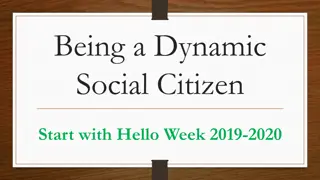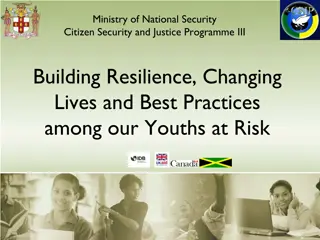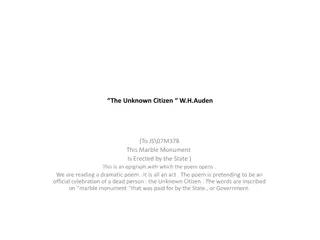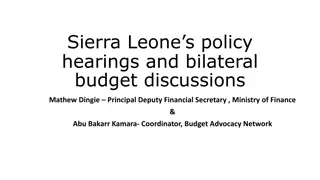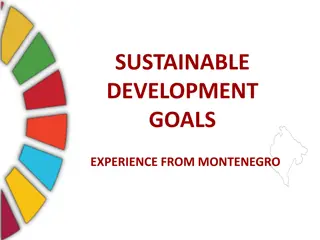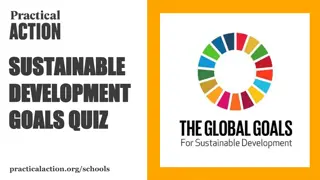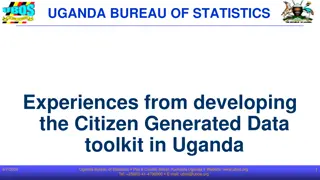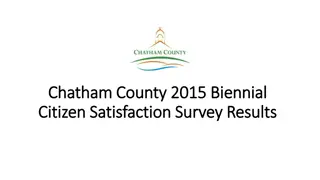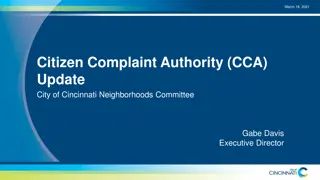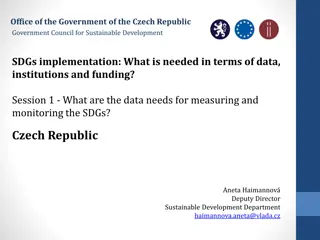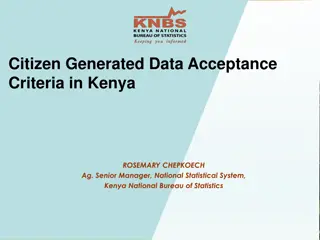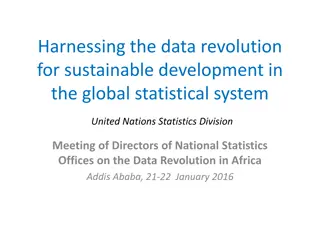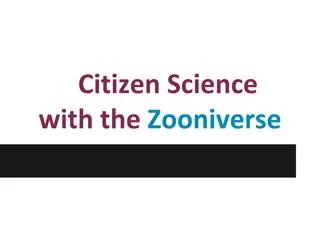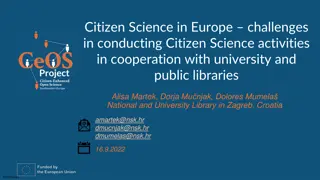Harnessing Citizen-Generated Data for Sustainable Development Goals
Citizen-generated data (CGD) presents a valuable opportunity to supplement official statistics and fill data gaps for monitoring progress towards SDGs. This alternative data source empowers citizens, fosters inclusive policymaking, and creates new spaces for engagement. By leveraging CGD, governments can enhance their decision-making processes and address community needs effectively.
Download Presentation

Please find below an Image/Link to download the presentation.
The content on the website is provided AS IS for your information and personal use only. It may not be sold, licensed, or shared on other websites without obtaining consent from the author.If you encounter any issues during the download, it is possible that the publisher has removed the file from their server.
You are allowed to download the files provided on this website for personal or commercial use, subject to the condition that they are used lawfully. All files are the property of their respective owners.
The content on the website is provided AS IS for your information and personal use only. It may not be sold, licensed, or shared on other websites without obtaining consent from the author.
E N D
Presentation Transcript
Leveraging citizen generated data -opportunities and challenges Localizing SDGs and NDS-1 Through Voluntary Local Reviews in Zimbabwe 4-6 October 2023, Hotels Kadoma Hotel and Conference Center, Amson Sibanda Division for Sustainable Development Goals, UN DESA
Citizen Generated Data and SDGs Monitoring Official statistics have traditionally been relied upon to craft policies and to measure SDGs progress and national plans. But there are still huge gaps and many countries are struggling to obtain relevant, timely, disaggregated data to track progress. Alternative data sources such as citizen-generated data (CGD), geospatial data, mobile data, and big data have become increasingly relevant to help close the data gap. Division for Sustainable Development Goals
Citizen Generated Data and SDGs Monitoring CGD has a high potential to monitor and drive progress on a country s development, including towards SDGs by Citizenship: Creating new relationships and public spaces Monitoring: Informing, expanding, and improving SDG monitoring Implementation: Informing public policy goals and community- driven problem solving Division for Sustainable Development Goals
What is Citizen Generated Data? CGD is defined as data that people or their organizations produce to monitor, demand directly, or drive change on issues that affect them. The UN Statistical Commission convened in March 2022 recognized the value of CGD in filing data gaps. National Statistical Offices are increasingly recognizing CGD as a valuable data source in pursuing sustainable development to help fill evidence gaps NSOs can support and guide producers of CGD to comply with statistical quality standards and improve their usefulness. Division for Sustainable Development Goals
Benefits of Citizen Generated Data These data can provide timely and granular data on community issues, supplementing official data sources and helping to shape development policies that are inclusive and responsive to community needs. Fosters creation of new spaces for national, local and regional governments and their citizens to engage Promotes the inclusion of citizens in public decision-making at different levels of government. Empowers citizens by engaging them in one or several stages of the data value chain: collection (e.g. censuses and surveys), publication, uptake, and impact. Division for Sustainable Development Goals
Benefits of Citizen Generated Data CGD increases data availability, particularly on marginalized people, who may often be left out of traditional surveys and censuses Hence, investments in a rich data ecosystem that supports CGD alongside official data sources: empowers the poor and groups in vulnerable situations provides a holistic understanding of marginalization, and supports inclusive decision-making to ensure that no one and no place is left behind in SDG implementation. a Division for Sustainable Development Goals
Countries Using CDG NSOs are experimenting with CGD to enhance official statistics. The Kenya Bureau of Statistics is building its capacity to use these alternative data sources. A practical guide was developed following a call by a call from CSO in Kenya for guidance on producing quality CGD. "Citizen-generated data in Kenya: a practical guide" The Philippines has identified multiple indicators under 12 SDGs suitable for CGD application. The Government of Viet Nam adopted 80% of LNOB Viet Nam s recommendations in its 2020 national report on SDG implementation Division for Sustainable Development Goals
E.g. Identifying the ultra-poor using CGD How do we end the worst forms of human poverty? Bangladesh defined the ultra poor as those living on 60-70 cents a day or less - the majority tends to be landless rural women They are trapped in the worst forms of destitution, are the most vulnerable, lack the skills needed to lift themselves out of extreme poverty. They often do not benefit from market-based interventions like microfinance. Development and growth tend to leave them behind; they are unable to break free from extreme poverty despite their hardest efforts Division for Sustainable Development Goals
E.g. Identifying the ultra-poor using CGD The very poorest can graduate from ultra-poverty with a set of carefully targeted, sequenced, tailored interventions. Building Resources Across Communities (BRAC) s methodology has been used. BRAC serves 126m people in 17 countries in Asia, Africa, the Americas BRAC s targeting process begins by identifying geographic locations with a high concentration of ultra-poor households Next step is participatory wealth ranking. Groups of 40-50 villagers are asked to discuss and rank the wealth of every household in the village Division for Sustainable Development Goals
E.g. Identifying the ultra-poor using CGD Programme staff follows up with door-to-door visits, using questionnaires to determine who qualifies. More senior managers are then required to verify the final selection. Selected HHs are given a productive asset (e.g. livestock, agricultural inputs, capital for small trading); receive training on how to use their new asset; weekly stipends, participate in savings programmes; health care; social integration After 18 to 36 months, 75% to 98% of participants met graduation criteria. Division for Sustainable Development Goals
Challenges NSOs perception towards CGD is improving but they are still concerned about data quality and methodological coherence. CGD is perceived to lack credibility due to limitations of low coverage and insufficient initiatives to represent a population or area of interest. With the stewardship of National Statistical Offices, standardized guidelines and data partnerships can contribute to the extensive use of these data. CSOs can conduct CGD initiatives that comply with statistical quality standards similar to those used by NSOs. Division for Sustainable Development Goals
Way forward UN Statistical Division and the LNOB coalitions are developing a global quality assurance toolkit for CGD producers, built on national level experiences. Producing guidelines will help translation of statistical concepts, principles, and processes into everyday language, enabling CSOs to produce data and statistics that comply with quality standards. Beyond guidelines, more investment efforts should be targeted towards strengthening CGD. Its important that CGD contributes to the development discourse coming out of people s voices, experiences and life stories if countries are to LNOB. Division for Sustainable Development Goals





